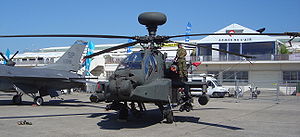Aigios Aquila
| Aigios Aquila | |
|---|---|

| |
| Role | Attack Helicopter |
| Designer | Aigios International |
| First flight | 12 August 1974 |
| Introduction | 20 May 1985 |
| Status | In service |
| Primary user | Belfrasian Army See Operators |
The Aigios Aquila is a four-blade, turbo-shaft attack helicopter produced by Aigios International for service with the Belfrasian Army, the ground force of the Belfrasian Armed Forces. The helicopter is designed with a tail-wheel landing gear arrangement, a tandem-seated cockpit for a two man crew and a heavily specialised nose-mounted sensor suite for usage in target acquisition and visual aide. The helicopter is armed with a 30mm chain-gun mounted between the front landing gear and is capable of 360-degree angles of fire. Six hardpoints are mounted on stub pylons for carrying armament and stores, typically a mixture of Agkulis and Scorpion laser-guided missiles. Two of the pylons, both of which are mounted on the tips of the stub pylons, are made specifically to be mounted by Pilum air-to-air missiles.
Design
Operational History
Variants
- AH.1
- The AH.1 was the original production model of the Aquila, already included the tandem armoured cockpit adopted in the design phase and it's turboshaft engines. The model stayed in primary service from 1985 to 1991 when it was outdated with a newer version as a result of in-service discoveries.
- AH.1/A
- The /A sub-variant of the AH.1 was introduced in 1992, with remaining AH.1's upgraded to the /A model to copy the AH.2's new electrical computer systems.
- AH.2
- In 1991 the AH.2 was brought service with a new, sturdier rotor blade design along with Global Positioning System (GPS) computers, improved navigation and an ability to communicate via encrypted frequencies. The new electrical systems were eventually fitted on the AH.1 models in the form of the AH.1/A
<imgur thumb="yes" w="100" comment="The 'Tower' fire control platform introduced on the AH.4.">icrfiSL.png</imgur>
- AH.3
- Funding in 1993 by the government saw the development of the AH.3, which includes glass cockpit displays, a head-tracking system for the nose gun and an improved engine mount system to reduce maintenance costs. AH.2 refits to the newer AH.3 platform stalled in 1997 as a result of budget cuts and was eventually scrapped altogether. The refit program was scheduled to be revisited in 1999 but was delayed as a result of expectations of the AH.4 program.
- AH.4
- The defence budget of 2000 saw the inclusion of a major upgrade fund for the Aquila, notably for the development of an AH.4 model. The new model, referred to as the 'Tower' model for the advanced target acquisition system mounted above the rotors. The 'Tower' system is a millimeter-wave fire control radar system that allows the helicopter to sit behind obstacles such as terrain, trees or buildings whilst the 'Tower' system remains held above the obstruction. The advanced fire control system can track up to 130 targets and is capable of guiding ordnance from it's platform or others onto 15 targets at once. The radome also includes more advanced communication systems to allow the platform to transfer detailed target information for other platforms to lock onto and fire before the sensing platform also takes control of the ordnance if necessary. The AH.4 brought in a brand-new glass cockpit system and a head-tracking system for the gunner to direct the nose cannon at targets by 'looking' at the contact through his helmet mounted display.
- AH.5
- The AH.5 is the latest version of the Aquila, first seen in 2013. The AH.5 features a fully revamped sensor system, called the Joint Intelligence Distribution System, significantly more powerful engines and an ability to control unmanned aerial vehicles within the area of operations. The platform also saw the addition of an AESA Radar installed in the 'Tower' mount and a smart diagnosis system for damage taken in battle to be quickly analysed and relayed to the pilot, indicating whether or not the platform needs to abort and return to base.
Operators
Specifications
General characteristics
- Crew: 2 (Pilot, Gunner)
- Length: 17.73 m (58.2 ft) ()
- Rotor diameter: 14.64 m (48.0 ft) ()
- Height: 3.87 m (12.7 ft) ()
- Empty weight: 5,170 kg (11,400 lb) ()
- Max. takeoff weight: 10,443 kg (23,023 lb) ()
- Powerplant: 2 × Augmenn 6500 turboshaft, () each
Performance
- Maximum speed: 183 mph (295 km/h)
- Combat radius: 312 mi (502 km) ()
- Ferry range: 1,180 mi (1,900 km) ()
Armament
- Guns:
- 1 x 30mm chain gun with 1,200 rounds
- Hardpoints: 6: 4 stub-wing pylons, 2 pylons on wing-tips specifically for twin-packed Pilum
- Other:

